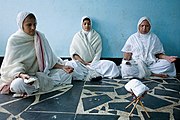Jain meditation is called Samayika. The word Samayika means being in the moment of continuous real-time. This act of being conscious of the continual renewal of the universe in general and one's own renewal of the individual Jiva in particular is the critical first step in the journey towards idenfication with one's true nature, called the Atman. It is also a method by which one can develop an attitude of harmony and respect towards other humans and Mother Nature.
One begins by achieving a balance in time. The act of being conscious of the continual renewal of the universe in general and one's own renewal of the individual Jiva is the critical first step towards identifying with the Atman. By being fully aware, alert and conscious of the constantly moving present, one will experience their true nature, Atman.
Practitioners generally sit in the Shiva, Buddha or Parshvanath posture. While others have been used by yogis and ohers, the 24 Jain Tirthankaras are always seen in this position.
Samayika gains a special significance during Paryushana.
Postures
 Jain sadhvis in Samayika
Jain sadhvis in SamayikaThe Samayika is done to practice meditation generally by sitting in the Kayotsarga(khadgasana) , Padmasana or Paryankasana[1] postures. Although other postures have been used by yogis and others, the 24 Jain Tirthankaras are always seen in one of these two postures. The image to the right shows Jain monks in Samayika. Jains visit their temples and are seen sitting in this posture in one-on-one Samayika sessions in front of Tirthankar statues, for example, a Jain temple in Blairstown, NJ USA.[2] Also included is an image of the Jain temple in Mt. Abu Rajastan, India.
Etymology
Samayika word comes from Prakrit language. The aim of Samayika is to transcend our daily experiences as the "constantly changing" human beings, called Jiva, and allow identification with the "changeless" reality in us, called the Atman. Is it possible to identify with the "changelessness" in us when constant change and renewal in and around us dominate our attention and energies? Samayika addresses this question. One begins in Samayika by achieving a balance in time. If the present fine moment of time could be defined as the moving line between the past and the future, Samayika happens by being fully aware, alert and conscious in that moving timeline when one experiences one's true nature, Atman, which is considered common to all living beings. The Samayika is derived from the word samay - meaning time - in the Prakrit language. The Samayika takes on special significance during special 8-day period practiced by the Jains called Paryushana. Also see Jainism for more.
History
Meditation techniques were available in ancient Jain scriptures that have been forgotten with time.[citation needed] The 10th Head of Jain Swetamber Terapanth sect Acharya Mahaprajnarediscovered a practice called Preksha Meditation which consists of the perception of the body, the psychic centres, breath and of contemplation processes which will initiate the process of personal transformation. It aims at reaching and purify the deeper levels of existence. Regular practice strengthens the immune system, builds up stamina to resist against ageing, pollution, chemical toxins, viruses, diseases, food adulteration.
Acharya Mahaprajna says:
Soul is my god. Renunciation is my prayer. Amity is my devotion. Self restraint is my strength. Non-violence is my religion.

Soul is my god. Renunciation is my prayer. Amity is my devotion. Self restraint is my strength. Non-violence is my religion.

No comments:
Post a Comment